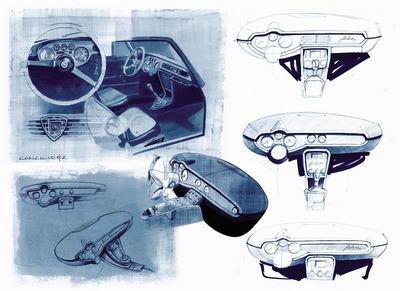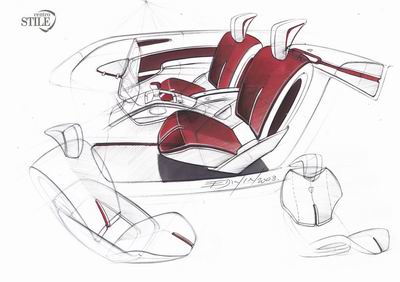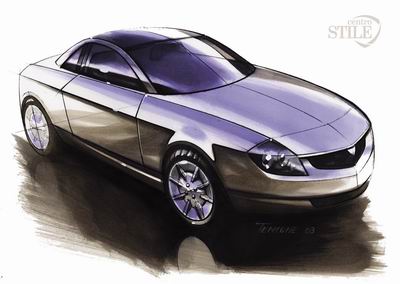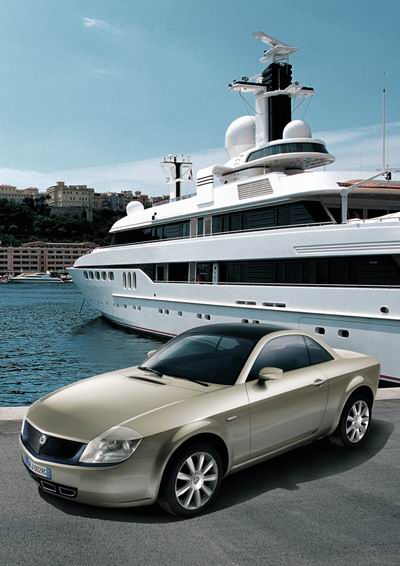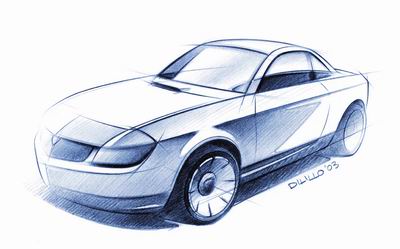 |
Lancia is one of the very few motor manufacturers than can
boast customers who are demanding aficionados of the brand
and lovers of beauty yet also great connoisseurs of the most
sophisticated technology. A leitmotif links all Lancia cars:
a continuous quest for innovation linked to the most exclusive
Italian craftsmanship. This driving force is essential not
only to the spirit of Lancia but also to the progress of the
motorcar per se. The hundreds of patents filed, the brilliant
inventions and the practical creations developed by Lancia
throughout nearly one century of history bear witness to this.
The year was 1965. At the Geneva Motor Show, Lancia introduced
the Fulvia Coupй 1.2, a powerful, well-balanced car that was
absolutely unique for the mechanical solutions adopted. The
model's great strength lay in its engine configuration of
4 cylinders in a narrow V. The front subframe housed the power
unit while the front suspension was double wishbone. The braking
system featured four discs with a dual hydraulic circuit and
brake servo.
The Fulvia Coupй was a fine example of the elegant sportiness
that has always typified certain models produced by Lancia.
It took just a few touches to convert a road vehicle into
a racing car. Even now, the public applies the HF tag indiscriminately
to the Fulvia Coupй model without distinguishing road cars
from cars destined for racing activities. Think back to the
legendary Fulvia Coupй Rallye 1.6 HF that won the Montecarlo
Rally in 1972 with Sandro Munari aboard and also raced off
with the world Brand Championship. The following year, the
Lancia model pulled out of official racing and in 1976 the
Lancia Fulvia Coupй ceased production after 140,000 had been
built.
And now, forty years on from the debut of the first Fulvia
saloon and thirty-one years after Munari's victory, Lancia
has decided to build a prototype to celebrate one of the models
that made the brandname famous throughout the world.
Apart from anything else, the Lancia Style Centre designers
have always had one perennial dream: to recreate the Fulvia
Coupй as though it had been left free to evolve without interruption.
The approach to the project was very clear from the outset:
no nostalgic self-indulgence but a post-modern reworking of
the original concept and styling cues.
Priority was to be given to a fresh, dynamic shape without
losing sight of the intrinsic spirit that made the Fulvia,
designed by Castagnero in 1965, an ultra-sophisticated mix
of eccentricity, elegance, clean aesthetic lines and sportiness.
An absolutely up-to-date coupй, in other words. A car that
offered an opportunity to explore aesthetic and engineering
solutions that could be used on future Lancia products but
also carried great evocative weight for people who lusted
after and dreamed of the car in its heyday.
The dimensions and three-box shape of the Fulvia Coupй show
car are practically identical to those of its predecessor
but the track has been broadened to give the car greater stability
and strength. The general layout is reminiscent of Riva motorboats
of the period, i.e. a truncated tail, an extremely dynamic
shape and a furrowing prow. The most distinctive stylist motif,
i.e. a continuous horseshoe-shaped band that enfolded the
entire body only to emerge at the tail, was reworked to give
the car a more dynamic appearance and a tapering shape. The
point of greatest tension lies over the front wheel where
all the visual weight of the car is also concentrated to underscore
the front drive and engine. The end result is that the entire
car appears to be pulled along from this point. The drop-shape
of the car from above with maximum width at the front and
a tendency to taper off toward the truncated tail also contributes
to this effect. The shape is complemented by a long bonnet,
a small glazed area and a specific weight distribution pattern.
The 1965 Fulvia Coupй featured a characteristic lightness
of volume that was even more evident at the rear. The new
show car, however, is more muscular in appearance but lightened
by fact that the lower part of the vehicle recedes toward
the tail.
The aggressive-looking front features a broad, rounded bonnet,
headlights made out of high-tech modules and a wing-shaped
'brow' that extends the bonnet profile visually below the
lights.
The burnished metal grille that bears the big Lancia shield
looks sporty and three-dimensional. It has been deliberately
deconstructed and simplified compared to its less aggressive
sisters to emphasise the function of the air intake and create
a relationship between solid metal and air at the front that
reflects the pattern of the previous model.
Everything is completed by lines that flow from the bonnet
to the bumpers and gather around the lower outlet where four
floating quadrangular cylinders hark back to the four air
intakes of the Seventies model. The clean sides hinge on a
succession of concave and convex surfaces and a sturdy shoulder.
The tail, the logical conclusion to the entire shape, marks
a return to the cross section of the original model: it would
hardly be complete without a deliberate reference to the aft
surface that was such a distinctive feature of the previous
model and underscored the fleeting tail while providing an
unfussy frame for the tall headlights. These features, run
though by two cylinders that encircle the body like exhaust
pipes, depend for their effect on a transparent covering that
reveals how the lamps overhang from the wing-shaped profile
(a subtle hint of the expressive 'eyes' so typical of the
previous car).
The three-coated Ivory body colour offers a harmonious contrast
with the dark brown 'Testa di moro' leather that enfolds the
passenger compartment. The interior has a decidedly Seventies
feel with parts (manufactured using numerically controlled
lathes) that are reminiscent of the iridescent controls on
hi-fi systems of the period. The Tanganika Frisй wood that
covers the central facia insert and tunnel bridge is silky
in appearance with a metallic sheen.
The interior features two bucket seats and an additional luggage
compartment under the parcel rack. Its appearance is inspired
by the original, though with a spare post-modern treatment.
All the sophistication and sporty touches you would expect
from a Lancia of this type are naturally in evidence. Examples
include a set of bags produced specially for the show car
by Trussardi using top-class original panels that represent
an ideal combination between mood and practicality.
The facia, made out of two opposing, hand-upholstered shells
that embrace the leather insert, appears to be surrounded
by a shell that stretches smoothly to the rear of the door
panel to underscore a drop-shaped floor plan of nautical inspiration.
The tunnel is actually an extension of the dark brown leather
trim on the floor that flows fluidly up to form arms that
mirror the armrests on the doors. The saddle-shaped theme
reflects the formal language of the entire interior. If you
sliced through the volume of the tunnel and the side armrests
you would see a longitudinal wooden bridge in the centre that
houses a gearlever (enhanced by aluminium parts) with looped
door pulls on the doors.
The overall look is rounded off by a three-dial analogue instrument
cluster of nautical design that is pearlised in colour (similar
to that of the new Ypsilon). A metal interface plate contains
all the infotainment functions and the climate control system
as on other Lancia range vehicles.
A steering wheel with three metal spokes contains a cylindrical
airbag module and a leather-upholstered rim. The sporty, ergonomic
seats are reminiscent of those on the Fulvia Coupй because
the wraparound horseshoe embraces the backrest to offer broad
lateral support.
Yet the Fulvia Coupй styling operation was never a mere exercise
in design. All the car's exterior parts have been developed
to keep down drag. The fruits of this effort are evident in
the good top speed of 213 km/h, obtained from a power output
that is somewhat restrained for this type of vehicle: 140
kW (103 bhp) at 6400 rpm.
Engine lightness is assured by the use of aluminium to create
the body. As on all the most up to date sports cars - though
some HF versions of the Seventies Fulvia Coupй also featured
aluminium bonnet and doors - all exterior body panels are
in aluminium. This feat of engineering has been pulled off
by calling in the very best hand panel beaters. In this case,
the model manufacturer, CECOMP, has done a masterly job.
This attention to lightness also allowed the weight to be
kept below 1000 kg. The Fulvia Coupй weighs exactly 990 kg,
an absolutely outstanding value for this vehicle type. It
also guarantees an excellent weight/power ratio (7 kg/bhp)
and acceleration from 0 to 100 km/h in 8.6 seconds. All this
naturally means reduced fuel consumption: over a combined
cycle, for example, fuel consumption never exceeds 7.3 l/100
km.
The Lancia prototype is also equipped with a 4 cylinder 1.8
16v engine with variable valve timing and a McPherson front
suspension layout with telescopic struts, coaxial coil springs
and lower wishbones. Although the geometry is relatively simple,
it ensures a dynamic first rate performance aided by Pirelli
PZero Nero tyres. The technical picture is completed by rear
suspension with longitudinal arms, antiroll bar, braking system
with four disc brakes (the front ones are ventilated) and
an ABS.
No other electronic gadgets have been added, such as antislip
or stability control devices, because we did not wish to detract
from the purity of the car's wonderful old-style sporty drive.
The Fulvia Coupй is fully entitled to a place in the wish
list of people who know how to appreciate a car of great personality
and charm even if it is a pilot model. Even today, Lancia
aficionados are known for the extraordinary passion and enthusiasm
that they share with those who design, test and produce Lancia
cars.
Lancia thanks the following for their help
in producing the Fulvia Coupй show car: Alcantara, Akzo Nobel,
Aunde Italia, Bose, CECOMP, Frau, IXFIN Magneti Marelli, Mario
Levi, Novem, Pirelli, PPG, Radicar, Shafenaker, Sintesi Photo
Etching, Tabu, Toora, Trussardi, Zanini.
|




